The size of the foot is individual for everyone, it is very difficult to choose shoes without a baby. But you can roughly determine the size of a child’s shoes by age or foot length. This will help make your purchase successful.
How to determine the size of shoes for girls according to age
For manufacturers of children’s shoes, the size of the shoe for girls is different. Therefore, before buying, you need to clarify the length of the child’s foot in centimeters. Measure it before going to the store. Bring a ruler with you to measure the sole of your shoes.
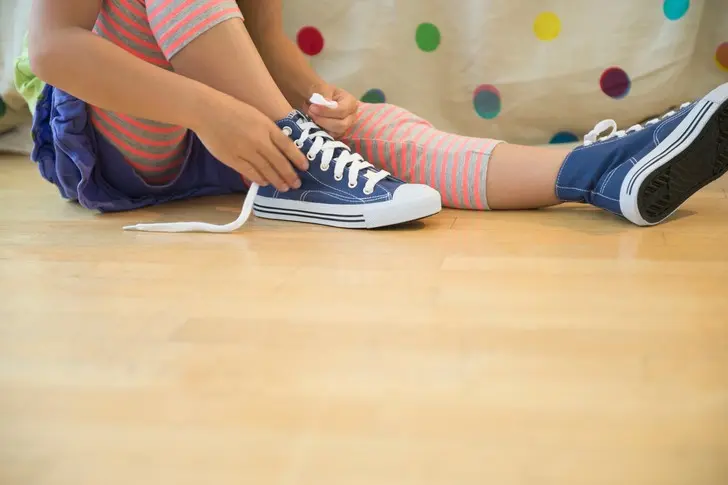
Child’s shoe size depends on age
Do not forget about the stock: in children’s shoes, 1 cm is considered optimal. Too much stock leads to improper development of the foot.
How to find the right size:
- 3-6 months – foot length 9,5-10,5 cm – size 16-17;
- 6-9 months – length 11-11,5 cm – size 18-19;
- 9-12 months – rate 12-12,5 cm – size 19,5-20;
- 1-1,5 g – length 13-13,5 cm – size 21-22;
- 2-3 g – foot 14-15,5 cm – size 22,5-25;
- 4-5 years old – length 16-17 – size 25,5-27;
- 6-8 years old – foot 19-20,5 – size 30-32;
- after 9 years – length 21-23 cm – size 33-36.
When the child begins to walk, the foot grows faster. After 3 years, the foot grows by an average of 1 cm per year.
Up to 12 months, the foot in children grows approximately the same, so when buying, you can focus on general standards. In one-year-old boys, there is a noticeable leap in growth.
Shoe size by age:
- 1-1,5 g – foot 13-14 cm – size 21-22,5;
- 1,5-2 g – length 14,5-15 cm – size 23-24;
- 2-3 g – length 15,5-16,5 cm – size 25-26;
- 3-5 years old – foot 17-18 cm – size 27-28,5;
- 5-7 years old – foot 18,5-21 cm – size 29-33;
- after 7 years – length 21,5-23 – size 34-36.
When buying summer shoes, add 0,5 cm to the resulting size, as in summer the leg grows faster. For boots, the increase is 1,5 cm so that the child can put on a warm sock. Choose shoes one season ahead.
Remember that in children under 3 years of age, the leg changes every 3 months. Thereafter, up to 6 years of age, the size changes every 4 months. Until the age of 10, the foot continues to grow every 5 months.
For babies up to one year old, the foot is measured with a tape measure. When a child walks, it will be correct to measure it while standing, because under load the foot changes.
If a child has one foot larger than the other, then the shoes are chosen according to a larger indicator so that they are not tight.
Try to measure the foot as accurately as possible, take into account the age of the child and the seasonality of the shoe, the rate of growth of the foot. Do not neglect these recommendations, then the purchase will not disappoint.
General table of matching the sizes of children’s shoes by the age of the child
| age | leg length | UK | EU | US |
|---|---|---|---|---|
| 0 – 1 months | 8.6 | 0 | 15 | 0 |
| 0 – 3 months | 9.3 | 0 | 16 | 1 |
| 3 – 6 months | 10 | 1 | 17 | 2 |
| 6 – 9 months | 11 | 2 | 18 | 3 |
| 6 – 9 months | 11.6 | 3 | 19 | 4 |
| 9 – 12 months | 12.3 | 4 | 20 | 5 |
| 12 – 18 months | 13 | 4.5 | 21 | 5.5 |
| 18 – 24 months | 13.7 | 5 | 22 | 6 |
| 2 years | 14.4 | 6 | 23 | 7 |
| 15 | 7 | 24 | 8 | |
| 3 years | 15.6 | 8 | 25 | 9 |
| 16.3 | 8.5 | 26 | 9.5 | |
| 4 years | 17 | 9 | 27 | 10 |
| 5 years | 17.7 | 10 | 28 | 11 |
| 6 years | 18.4 | 11 | 29 | 12 |
| 7 years | 19 | 12 | 30 | 13 |
| 8 years | 19.7 | 12.5 | 31 | 13.5 |
| 20.4 | 13 | 32 | 1 | |
| 9 years | 21 | 1 | 33 | 2 |
| 10 years | 21.7 | 2 | 34 | 3 |
| 11 years | 22.3 | 2.5 | 35 | 3.5 |
| 12 years | 23 | 3 | 36 | 4 |
| 13 years | 23.6 | 4 | 37 | 5 |
| 14 years | 24.3 | 5 | 38 | 6 |
| 15 years | 25 | 6 | 39 | 7 |
| 16 years + | 25.7 | 7 | 40 | 7.5 |
| 26.4 | 8 | 41 | 9 | |
| 27.1 | 9 | 42 | 10 | |
| 27.8 | 10 | 43 | 11 | |
| 28.5 | 11 | 44 | 12 | |
| 29.2 | 12 | 45 | 13 | |
| If a child’s foot is right up to the end of the shoe, it’s too small. There should be a thumbs width of space between the toes and the front of the shoe. Remember though, that shoes that are too big can do as much damage as those that are too small. | ||||
How to measure the total length of a child’s foot
The first thing to do when choosing shoes, shoes, boots or sandals for a baby is to measure his foot. It is recommended to perform this procedure in the evening, at this time of day the ankle is most “trampled” and increased by 5-8%.
To take measurements, do the following:
- put the baby on a piece of paper so that its weight is evenly distributed;
- circle the contours with a felt-tip pen or pencil;
- measure the distance from the middle of the heel to the tip of the thumb with a ruler on both legs. If their length is different, you should focus on those numbers that are larger;
- 1-1.5 cm should be added to the results obtained. You can also check the gap with the little finger of an adult. It should pass freely near the back.
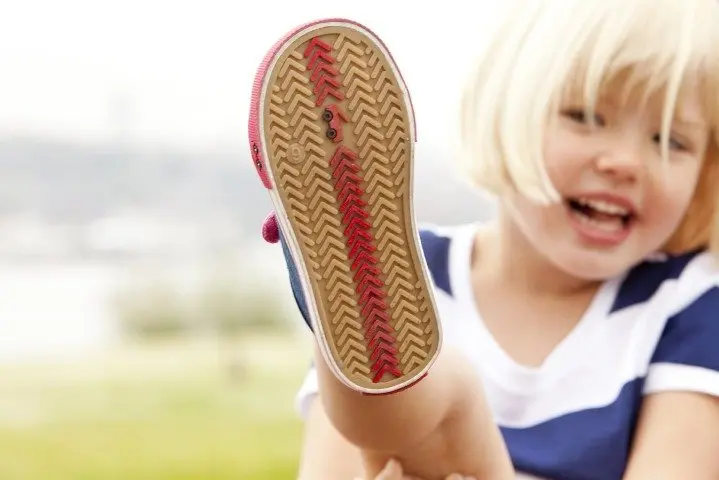
In addition, there are several nuances that should be remembered when measuring. If the baby is too small, you can find out the necessary parameters using a thread or rope. It is recommended to determine the size of a child’s shoes for closed models by measuring the foot in socks.
The nuances of choosing comfortable and reliable shoes
High-quality products are not only comfortable to wear, but also harmless to the baby’s musculoskeletal system. Smartly selected models will help to avoid various diseases, as well as the incorrect formation of a growing foot. After choosing the optimal children’s shoe size in centimeters, it is recommended to pay special attention to its characteristics.
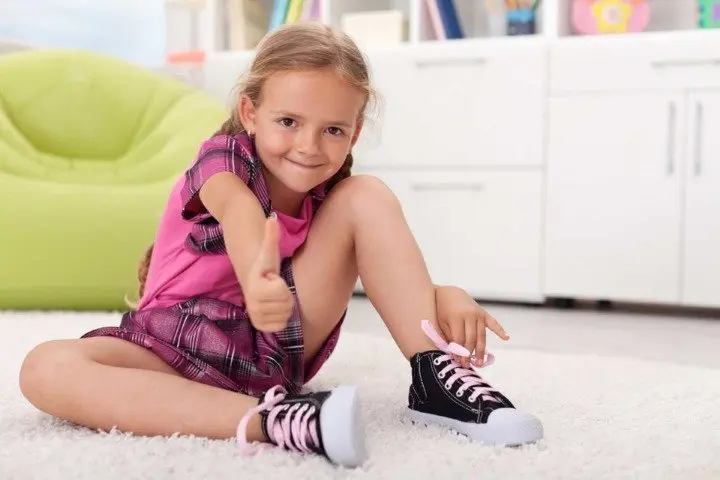
Important features of quality products:
- the presence of an arch support that prevents the occurrence of flat feet;
- light weight for comfort
- comfortable toe, preferably round. This option will not squeeze the fingers on the sides;
- material type. For a summer wardrobe, it is worth choosing goods made of genuine leather, which allows the covers to breathe; boots or boots made of membrane fabric with a warm lining that protects against moisture and cold are suitable for the winter;
- outsole flexibility and slip protection. You should also choose variations with a slightly protruding toe. Such a solution will protect the product from damage on curbs and uneven roads;
- comfortable laces or Velcro. For crumbs, simpler fasteners are suitable, and a student of elementary grades can easily cope with lacing;
- neat design of the model. Of great importance for a long and pleasant use of a pair is the quality of the seams and fixation of the sole. Reliable products will not cause discomfort and will last as long as possible.
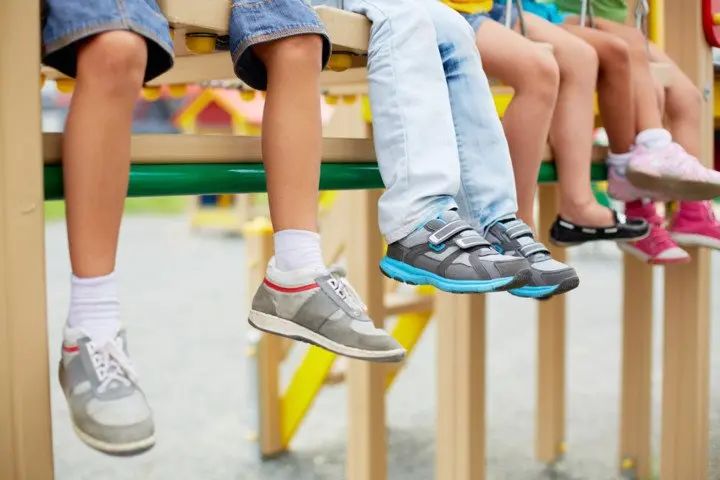
5 common misconceptions
Dimensional grid of children’s shoes in cm and tips for choosing it from this article will help you find the best deal. However, it may still not live up to expectations and even cause health problems. All wines are common misconceptions about some properties of goods.
- Products need to be bought for growth, as children grow up quickly. Too large products are not only uncomfortable in daily wear, but can also harm the developing foot.
- A representative of the younger generation needs 1-2 pairs for each of the seasons. Daily wearing of the same shoes or boots will quickly make them unusable, they will not have time to ventilate and dry, which contributes to the multiplication of dangerous microorganisms.
- All children need orthopedic shoes. Such products have their advantages, but for an absolutely healthy child, they are not an absolute necessity.
- You should purchase models with elements that treat flat feet. Not all children have this problem. Wearing pairs with such features can adversely affect the growing leg;
- Toddlers need to wear products with high ankle boots that firmly fix the ankle joint. In the absence of diseases of the musculoskeletal system, such support is inappropriate.
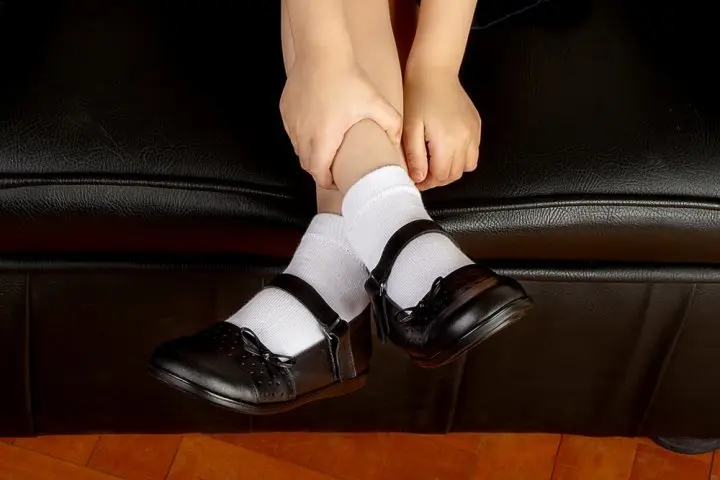
Focus on these standards:
- tough, thick, but quite flexible sole made of leather, rubber or polyurethane, which ensures the correct roll. This option will protect against injury and soften the blow when resting on the foot;
- Heel height 0.5 cm
Shoe size for children by age in centimeters: final tips
- Measuring it once every couple of months will help you navigate the growth dynamics of the crumbs, regardless of the frequency of buying shoe products. Up to 3 years, the length of the foot increases by as much as 2-3 indicators per year, in the period up to six years, about 2 dimensional marks are added, with the beginning of school – 1-2 each.
- When ordering shoes for the future, it is worth remembering that in the summer, kids grow up faster, and in winter and in the off-season, slower. Buying a model for school at the beginning of summer may be pointless, and ordering summer sandals in winter is a good idea.
- The most accurate measurements of the legs of a crumb up to 2 years old are measurements taken no earlier than 2 months before the purchase, a preschooler – 3 months, a younger student – no more than 4 months.
- In girls and boys, the difference in parameters can reach 30%, so you should not focus on the data of a brother or sister at the same age.
- If there are concerns about choosing the wrong size of children’s shoes for age in cm, this task can be further simplified. When taking measurements of the legs, it is recommended to cut out the contour of the foot from paper and go to the store with it. Applying such an insole to the models you like will significantly speed up the process.
- When deciding on suitable winter boots or warm boots, you can safely add 1-2 numbers to the parameters of the child. This will allow you to wear tight tights and socks in cold weather.
- Do not chase too cheap or expensive product. The first option will soon lose its original appearance and properties, the second is inappropriate due to the rapid growth of the child.
The tips from this article will help you put on your baby’s shoes quickly and easily, and choose comfortable and practical pairs for him for all seasons. And the most versatile choice of preventive, orthopedic shoes (for example, Orthopedic shoes ), winter, demi-season models for girls and boys at low prices is presented at OrtoPanda.










